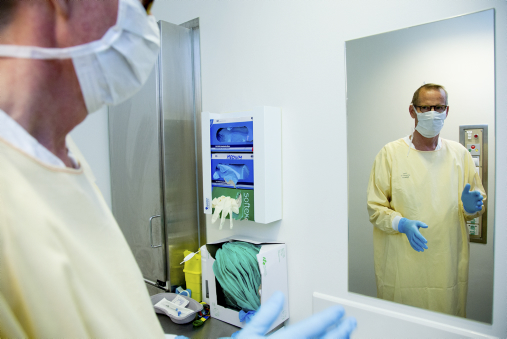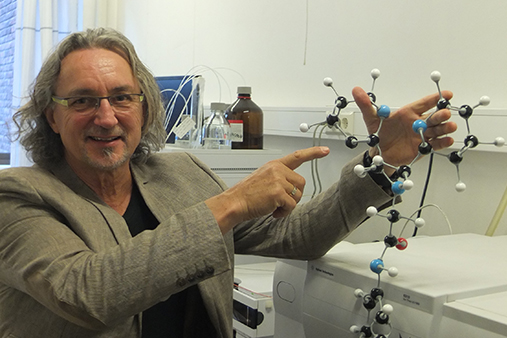Bacteria that develop resistance to the antibiotics that we use to treat infections represent an increasing problem that threatens public health.
‘Antibiotics have been used to cure life-threatening infections for 70 years. Now we can see that the bacteria are striking back and have developed resistance to the ‘miracle drug’. We risk that antibiotic resistance develops into a global threat to public health. If antibiotics lose their effect, this will have significant consequences for humans. Resistant bacteria may cause increased mortality, more diseases, longer hospitalization periods and obviously increased costs for health care,’ according to Hilde Nebb.
Interdisciplinary collaboration is required

Nebb is deputy chair of the University of Oslo’s (UiO’s) largest priority area ever – UiO:Life Science – in which interdisciplinary collaboration is a key feature. So, how may interdisciplinary collaboration in the framework of this programme help solve such a major, global challenge as antibiotic resistance?
‘Although the problems associated with antibiotic resistance may be huge, they can be solved by interdisciplinary collaboration between basic research, clinicians and industry. Progress in the fields of genetics, genomics and informatics will change the way in which infections and diseases are diagnosed and provide us with the ability to defeat the diseases more quickly when bacteria develop antibiotic resistance,’ Nebb explains.
‘These technological advances will definitely result in even faster diagnostic tools that will improve the way in which we will use antibiotics in the future. I am convinced that our excellent research communities in the field of life sciences at UiO will be highly important contributors to these efforts.’
What are antibiotics?
Antibiotics are used to cure bacterial infections in animals and people. Antibiotics are agents that kill germs without harming animals or people. Antibiotics have no effect on viruses. Bacteria have various ways to develop resistance to antibiotics.
Article series
The University of Oslo is undertaking a number of projects in the field of life sciences aiming to address the increasing problem of antibiotic resistance. This is the third in a series of three articles from UiO:Life Science on this topic.
Read the first article: Better digital management is needed to control the use of antibiotics.
Read the second article: Promising results from a new agent to combat antibiotic-resistant bacteria.
Many research groups are on the case

UiO has a number of life-science researchers who are working on antibiotic resistance. Some of them are seeking to ensure more sensible use of antibiotics in hospitals and more sensible prescribing practices among general practitioners (GPs). This is essential to cut down on the unnecessary use of antibiotics, since every increase in their use raises the risk that the bacteria develop resistance.

Others seek to understand fundamental mechanisms inside the bacteria, how they develop in general and how they become resistant to antibiotics. Some are investigating bacteria in so-called biofilms, a kind of mucous layer that protects the bacteria against antibiotics and our immune system. Others are seeking to develop new drugs.
Here you can see a selection of UiO’s life-science researchers who are working on issues of antibiotic resistance:
Research to help ensure more sensible use of antibiotics
- The Institute of Clinical Medicine, Faculty of Medicine, hosts a research group for rational antibiotic treatment. The group investigates how the use of antibiotics can be improved to prevent or delay development of resistance, and thus preserve the effectiveness of those antibiotics that are currently on the market. The group is headed by associate professor and doctor Dag Berild. He believes that digital management is required to bring the use of antibiotics under control.
Read more on the research group’s website (in Norwegian). - The Institute of Health and Society hosts the Antibiotic Centre for Primary Care. The centre’s objective is to promote rational and restricted use of antibiotics in the primary health services, and thus reduce the development of antibiotic resistance in Norway. The centre includes a number of researchers working with various sections of the population, such as pregnant women, children and the elderly. One of the centre’s key tasks is to revise and implement the National guidelines for antibiotic use in the primary health services in cooperation with the Norwegian Directorate of Health. The centre has translated the European educational resource pack e-bug, which is intended for students in primary and lower secondary schools.
Professor Morten Lindbæk is head of the centre.
Read more on the centre’s website. - At the Institute of Clinical Medicine, a research group for infections and immunology is working on issues including antibiotic use and development of resistance in bacteria. The group’s objective is to improve diagnostics and treatment of serious infections in children. Establishment of biobanks and a quality register are key elements of this work.
Professor Tore G. Abrahamsen heads the research group.
Read more on the group’s website (in Norwegian). - At the Department of Biostatistics, Institute of Basic Medical Sciences, biostatisticians are using statistical models in their research on antibiotic resistance. At their Centre for Research-based Innovation, BigInsight, they conduct a number of projects on infectious diseases. They study such issues as how infectious diseases spread, how information spreads and the effect of various vaccination strategies. They have also investigated how the movement patterns of patients in hospitals can help us understand how resistant bacteria spread. The head of department, Professor Arnoldo Frigressi, has previously also studied how contagion spreads in aquaculture installations.
Read more on the department’s website. - Associate Professor Anne Kveim Lie at the Department of Health and Society has headed the work on an article on historical perspectives on antibiotic resistance, which was published in an interdisciplinary journal earlier this year. Professor Christoph Gradmann also participated. In 2012, the researchers completed a project on the history of antibiotic resistance in Norway.
Research on fundamental mechanisms in bacteria and the quest for new antibiotics
- The interdisciplinary strategic research initiative CIME (Centre for Integrative Microbial Evolution) at the Faculty of Mathematics and Natural Sciences includes a number of researchers who are seeking to understand more fundamental mechanisms in bacteria. In September, CIME hosted an international symposium on antibiotic resistance.
- The head of CIME, Professor Michael Koomey from the Institute of Biosciences, is studying the evolution of bacteria. In his opinion, some lateral thinking is needed to come up with proposals for new antibiotics. He refers to an example in which a Boston researcher found out that bacteria must be grown in soils that represent their natural environment, not in controlled laboratory fluids, in order to persuade them to produce completely new compounds that have potential antibiotic effects. It is also crucial to have a better understanding of why antibiotics kill bacteria. Koomey studies the Neisseria bacteria that cause a number of diseases including gonorrhoea and meningitis in order to understand their pathogenic properties and to find new cures. Such fundamental insights are also an advantage when we set out to attack the bacteria with antibiotics.
- Professor Pål Rongved from the School of Pharmacy has obtained promising results from tests of completely new compounds on antibiotic-resistant bacteria.
- Professor Ole Andreas Økstad at the School of Pharmacy constructs models of how spore-forming bacteria create biofilms. In biofilms, the bacteria are protected against antibiotics and our immune system and may communicate with each other.
- Professor Dirk Linke at the Institute of Biosciences studies the surface of the bacteria which is important for their ability to create biofilms, rendering them more resistant to antibiotics.
- Associate Professor Hanne C. Winther-Larsen at the School of Pharmacy and her research group develop vaccines for aquaculture where antibiotics are used in large amounts for treatment. If the vaccines work, this could reduce the use of antibiotics that is released into the environment considerably. Read more about the project.
- Biofilms also feature prominently in the work of the researchers at the Department of Oral Biology, Faculty of Dentistry.
Professors Anne Aamdal Scheie and Fernanda Cristina Petersen head the CrossTalk project. In this project, they investigate how bacteria in biofilms on teeth and mucous membranes communicate with each other and with their host cells. The objective is to develop agents that will disrupt this communication and thereby do away with the bacteria. They are testing various compounds, including agents drawn from red algae. They collaborate with Professor Tore Benneche at the Department of Chemistry, Faculty of Mathematics and Natural Sciences.
Listen to an interview in ‘Ekko’ from August this year, where PhD scholar Kjersti Sturød talks about antibiotic resistance (17:19) (in Norwegian).
Read the article about a new substance that attenuates E.coli.
Read more about the CrossTalk project. - Professor Gareth Griffiths at the Department of Biosciences investigates how antibiotic treatment of tuberculosis can be made more effective. He seeks to develop therapies based on nanotechnology to treat tuberculosis and fish pathogens. He uses zebra fish to model infections.
